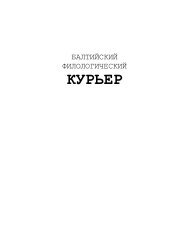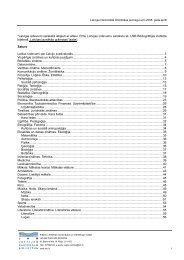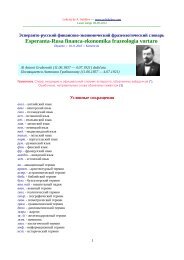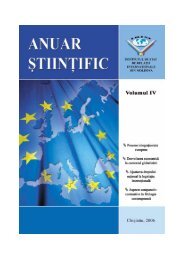Norge-Russland 2004/2005 Норвегия-Россия 2004 ... - TopReferat
Norge-Russland 2004/2005 Норвегия-Россия 2004 ... - TopReferat
Norge-Russland 2004/2005 Норвегия-Россия 2004 ... - TopReferat
Create successful ePaper yourself
Turn your PDF publications into a flip-book with our unique Google optimized e-Paper software.
Chekhov is aware of the limitations in the Ibsenian dramatic form. There is no doubt that he was<br />
Ibsen’s apprentice, and his dramatic practice will show that the Ibsenian form of drama was<br />
coming to its end. Chekhov sets to work where Ibsen fades out. In the first place Chekhov uses a<br />
far broader cast of characters and sets up groups of characters where Ibsen lets one character<br />
be representative of the group. Chekhov provides few stage directions and says little about nonverbal<br />
communication. It is only in Ivanov that we find a central figure, a main character, and a<br />
traditional train of action. Here we have a hero with vitality and the power to act, one the public<br />
can identify with. In his other plays the action is reduced to a state of standstill, the abstract. In<br />
Three Sisters the action dissolves and the characters are empty of positive energy. This is<br />
connected with the nature of the dialogue. Dialogue is interaction. When this ceases, the action<br />
comes to a standstill. The dialogue in Chekhov does not have a linear-causal structure, but it is<br />
circular (“equifinale”).<br />
In Three Sisters the dialogue – as in the absurdists – is conversation. The conversation departs<br />
from the principle of linear causality; it uses phrases, is often incongruent, it is split up into<br />
segments. Second, the conversation has a stabilising effect and does not promote action. In<br />
Chekhov we find long poetic monologues which are completely missing in Ibsen. The absurdists<br />
go even farther: the dialogue ceases in the end, and silence steps in. Dialogue, which in Ibsen<br />
served the action by virtue of the fact that it had the function of creating awareness and<br />
generating conflict, ceases after Chekhov. The lack of dialogue (interaction) reflects modern<br />
times, marked by absence of the power to act. Action designates a movement from one situation<br />
to another, a transition or change. A change cannot occur until a character, consciously and<br />
intentionally, sets in motion something goal-oriented in a given context.<br />
A distinction can be drawn between “action” and “event”: In the case of action, the subject<br />
consciously changes the situation; in the case of an event the subject becomes an object, yet a<br />
conscious object of a changing situation. In Three Sisters the women are not able to act, they are<br />
unwilling to identify themselves with their opponent, or they have other inadequate reactions to<br />
their surroundings. The absence of action is not necessarily connected with lack of cognition; it<br />
may also be a matter of reflection’s having taken the upper hand or of their being dominated by<br />
“inner or mental action”. A distinctive feature of Chekhov’s characters is un-uttered inner action.<br />
Stanislavsky emphasised that action had been replaced by restricted emotions.<br />
When lines are drawn between Ibsen and Chekhov, it is usually done by setting up their dramas<br />
in pairs: Three Sisters and Hedda Gabler, The Seagull and The Wild Duck, Uncle Vanya, The<br />
Cherry Orchard and Rosmersholm. This parallel interpretation of the thematic aspect has not<br />
been our purpose. What we have done is to point to Ibsen’s gradual dissolution of the action, and<br />
the increasing discrepancy between cognition and action. Then we pointed briefly to the way in<br />
which Chekhov further develops this in the direction of the absurdists.<br />
Петр Палиевский: Кнут Гамсун в европейской культуре<br />
Кнут Гамсун очевидно перебрался со своими проблемами в ХХI век, и нам надлежит<br />
встретить его здесь достойно. Его образы вышли за пределы Норвегии в разные стороны,<br />
и я буду говорить о нем тоже со стороны, – где его, правда, приняли с увлечением и<br />
радостью. Сторонний взгляд, возможно, дает повод увидеть стереоскопически его<br />
нынешнее присутствие в Европе.<br />
И первое, что бросается в глаза в его значении для всех нас, что это писатель природы.<br />
Верность природе проходит через всю его жизнь. В его последней книге311 , идеи которой<br />
во многом пропадают оттого, что в ней ищут политических выводов, он думает о ней<br />
прежде всего. Его тревожит молодая ель, он следит, появится ли ее желтеющая верхушка<br />
и старается убрать мешающие ей ветви старого тополя; его волнует, посреди, кажется,<br />
куда более важных дел, первый неумелый крик петуха: "Бедняга, он был один в целом<br />
311 Интересно, что ее "природное" заглавие почти совпадает с названием книги Мартина Хайдеггера<br />
"Hozwege" (1950), который также выдерживал в то время обвинения в сотрудничестве с нацистами.
















